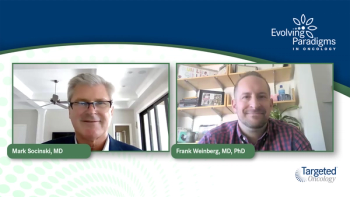
RR-DTC: Definition and Clinical Presentation
The panel of experts share their insights into the definition and clinical presentation of radioiodine-refractory DTC.
Episodes in this series

Lori Wirth, MD: It sounds like this woman has iodine-refractory differentiated thyroid cancer. Andrew, what is a good working definition for RAI [radioactive iodine]-refractory disease?
Andrew Gianoukakis, MD: We have missed this because at this point we are not sure that this is iodine-refractory disease.
Lori Wirth, MD: Oh, I’m jumping to conclusions; it’s a good reason I asked you the question.
Andrew Gianoukakis, MD: Yes. There are about 5 or 6 characteristics that will qualify a patient as being RAI-refractory. These definitions have been commonly used to classify patients as RAI-refractory and used to enroll patients in the clinical trials that have led to the approval of our systemic therapies. The most common radioiodine-refractory characterization is having received over 600 mCi of radioactive iodine and still having disease progression. Patients may have uptake in a metastatic lesion, and despite that uptake of radioactive iodine, the lesion grows over the ensuing months to a year. If we have solid, measurable disease that’s either locally or distantly metastatic, and it does not light up on an iodine scan, either diagnostic or post-therapy, that will qualify patients as radioiodine-refractory. In addition, knowing the inverse relationship between FDG [fluorodeoxyglucose] uptake and iodine uptake, many consider FDG-positive metastatic disease to be RAI-refractory, although that’s not 100%. In this case, we have had that initial therapy where, as we mentioned, the post-therapy scan lit up in the thyroid bed as was expected. It’s possible that the lung lesions were smaller at the time and also were precluded from taking up iodine because the thyroid remnant took up the iodine and those metastases were not noted at the time of the original therapy and post-therapy scan. It’s possible that these small lung lesions may take up iodine and may be amenable to additional radioiodine therapy.
Marcia Brose, MD: Can I ask a question about that? In this case, I know that we didn’t see another whole body scan that showed that the nodules were not taking up iodine, but do you see it often? This is probably more for you Andrew, when patients at one time point…after a dose of 150 mCi, and then 3 months later have new nodules showing up and growth of the ones that are there, does that tend to make you think that this is less likely to be iodine-responsive disease?
Andrew Gianoukakis, MD: Ultimately the answer is we don’t know. This is an aggressive course and one that is a little bit atypical. The more aggressive and rapidly progressive it is, and the fact that there’s a TERT mutation will make you wonder about RAI avidity. However, I can tell you that I’ve been surprised many times with RAI avidity and efficacy of radioactive iodine in cases that I highly suspected would not take up iodine, and of course the reverse. We do find ourselves in regard to predicting radioactive-iodine avidity in a challenging position where there’s a lot of hand-waving. Clearly in this case, small disease, largest lesion 1.1 [cm], only 1 dose of radioactive iodine so far, I think clinically you would opt for a second dose of RAI. Small lung lesions, lung lesions that tend to be more likely than bone or other distant disease to take up iodine and potentially respond. I do think that a second dose of radioactive iodine in this patient would be a reasonable option.
This transcript has been edited for clarity.










































